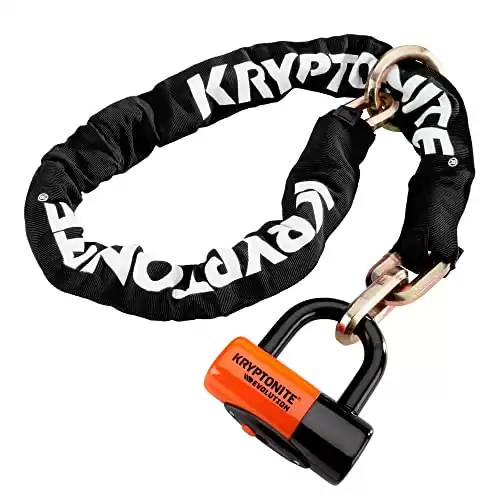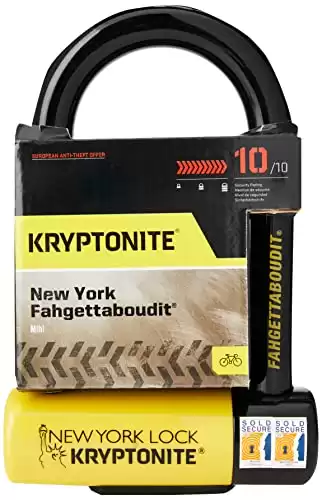A bike is stolen in the world every 30 seconds! A skilled lock-picker using the right tools can pick MOST locks in under a minute and ANY lock within less than 3 minutes. However, most bike thieves aren’t skilled lock-pickers, and the tools that can cut through or destroy chains and locks are usually big and/or loud. Let’s see how you can lock your bike in the most secure way, and the types of locks that offer maximum safety for your bicycle.
The best way to lock a bike is by using a secure bike lock that locks both wheels and the frame to a secure object at a frequented location. A safe lock is worth the extra cost, and taking the time to learn some best practices greatly reduces the chances of your bike being stolen.
The most important rule to keep in mind is that you want your bicycle to appear as a lesser appealing option to the thief than the other options available. You can do this by using secure bike locks that are hard to pick or cut, and by altering your bike’s appearance so it’s less enticing.
Here are the very best bike locks available right now, if you only want the quick version:
Electric bikes built for everything and priced for everyone. Shop Rad Power Bikes, America's #1 electric bike brand. Get out. Go further. Ride Rad.
Chain lock: Kryptonite New York Noose
U-Lock: Kryptonite New York Lock Fahgettaboutit
Folding lock: ABUS Bordo Granit X-Plus
Cable lock: THERE ISN’T A GOOD CABLE LOCK!
Good bike locks
Use a decent lock, or even several locks, if you need to lock your bike securely in a public area. The more you spend on a bike lock, the more protection it gives.

The more expensive your bike, the more you should spend on locks (about 10% of your bike’s value).
A $20 cable lock is an invitation to steal a $1500 bike. A more expensive U-lock like the Kryptonite Fahgettaboutit or a beefy chain like the New York Noose takes time to get through, whether by picking or by grinding, and it acts as a barrier to theft.
A $100 department store bike doesn’t need a very secure lock: thieves know the prices and value of the bikes and the risk they take with each lock.
Here are the various types of locks and what they can offer you.

Chain locks
Pros:
- Safety: they are usually the safest if prepared with other locks in the same price range.
- Versatility: they can wrap around odd-shaped objects easily
Cons:
- Weight: a good chain is heavy (but can be left at the office)
- Price: a good chain lock usually starts at around 80 dollars.
Remember
- 10mm wide links offer excellent protection (they also weigh the most)
- Weak chains can be snapped with a bolt cutter.
- Use a strong padlock
U-locks
Pros:
- Security: they offer high-security
- Weight and portability: they are lighter and, therefore easier to carry than chains (although I had issues fitting a new U-lock on my bike frame, so I had to return it)
Cons:
- Not flexible: because of their rigidity, it can be tricky to find an object to lock them to.
- Mounting issues on some bikes may mean that you need to get one separately or carry it in your backpack, pannier, or on your trousers.
Remember
Look for locks that lock both ends of the ‘U’ into the cylinder. Many U-locks don’t have this feature, which makes them easier to cut open.
Folding locks
Pros:
- Portability: as their name suggests, they fold up, which makes them very portable and easy to store on any bike
- Security: despite having rotating hinges, high-end folding locks are very secure and have few vulnerabilities.
- Flexibility: folding locks can be used on odd-shaped objects.
Cons:
- Weight: the most secure locks can be quite heavy.
- Price: a good folding lock starts in the 80-90 dollar price range
Remember
Some cheap folding locks can be easily opened with a nut-splitter, which makes zero noise.
Cable locks
Pros
- Price: they are the cheapest of all locks
- Portable and lightweight
- Good additional locks: they can be used to secure your seat or accessories to the bike frame
Cons
- Security: they can be cut easily
Remember
Don’t use a cable lock as your main lock, but rather as a second or third complementary lock.
Frame locks (aka cafe locks)
Pros:
- Always handy: these locks are attached to the bike frame and will always be available.
- Weight: they add little weight to the bike
Cons:
- Security: They only block the rear wheel no matter how strong they are. The bike can still be picked up and stolen.
Understand bike theft
An unlocked bike or a bike locked with a cable lock is not a risky task and can be stolen in seconds.
A securely locked bike presents a risk because it takes time to steal, and sometimes it involves a lot of noise.
Thieves are opportunistic and want to make as much money as possible in the shortest amount of time, trying to minimize the risk of being caught.
Most thieves that specialize in bikes are smart. They know the price and value of the bikes and how long it takes to steal a bike. They know the different types of locks and the weaknesses of each, whether you left your bike in an area where they can operate safely, the chances of getting caught, etc.
Based on the above factors, they decide whether they can handle the risk and steal your bike.
How to know how secure a lock is
To find out how secure a lock really is, we don’t need to rely on the integrity of the manufacturers.
Sold secure and ART Foundation are independent entities that test the different locks on the market and classify them according to their security level.
The Sold Secure security grading system uses three grades: Gold, Silver, and Bronze.
The ART Foundation in the Netherlands uses another grading system ranging from 1 to 5 stars.
How and to what should you lock your bike?
Pay attention to two things when you look for a place to lock up your bike:
- Find a secure object that you can lock the bike to
- Locking the bike in the safest manner possible
The safest object to lock the bike to is always cemented into the ground. Beware that some bike parking racks are only bolted into the ground and can be easily removed. These are commonly used in some cities.
Check the thickness of the rack also. Some racks are so flimsy that it is easier to cut them faster than your lock.
Sometimes it’s hard to find a proper rack to lock your bike to, and you need to use your common sense. Look for something immovable and sturdy if there are no racks available.
The most secure way of doing this is by locking the bike frame and the rear wheel to the rack with one lock and the front wheel to the rack or the bike frame with another, especially if the front wheel has a quick release.
Here’s a good visual summary:
Choose a secure location
Here’s a list of locations from most secure to least secure where you can lock your bike.
Take your bike indoors if you can. It’s the best way of keeping it safe. Even if it is a storage room or in a basement, you will keep it out of the public eye.
Lock your bike on private property. While not as safe as having your bike in the office or in the building’s basement, it’s the next best location.
Lock the bike in a frequented public area. Make sure that it is well-lit and it’s busy enough with sufficient foot traffic. Thieves don’t want to run into people when stealing. A busy neighborhood with lots of passers-by is not a comfortable zone to operate in.
If there are other bikes around where you want to lock your bike, check them. If they are damaged or parts are missing, it should be an alarming sign to look for a different location.
Debrand your bike
A flashy bike attracts more attention than an understated one. Bright colors, avantgarde looks, and high-end components are easily spotted. Use an average-looking bike to commute, and keep your flashy bike for weekend rides.
If your has a visible logo and the brand name on the frame, you can cover it with some tape or sticker. If you want a more permanent solution, you can cover the logo or brand name by painting it.
Conclusion
Bike theft has always been and will always be a worldwide issue. While you won’t be able to change human nature, there are a lot of things that you can do to make sure that your beloved means of transportation (aka your bike) remains yours for years to come.
Happy Riding!



